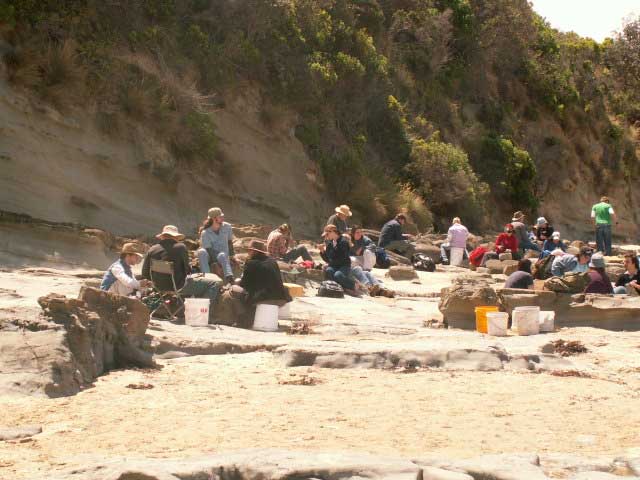
Discovering a fossil is a wonderful experience and palaeontologists become really excited when they go on a fossil-hunting expedition (which doesn't happen that often - usually they stay at home, in a stuffy lab, studying fossils that are kept in the storage room of a museum). And their expeditions normally start when a member of the public finds an unusual specimen and alerts the experts. But before you go gallivanting across the countryside attempting to find the "next big thing", you need to know what it is you are looking for.

As can be seen in the above picture, there are usually large teams involved in digging up a dinosaur. This is because there is A LOT of work that needs to be done. You need people to dig large amounts of earth and rock (sometimes done with a machine if the fossil is deep enough), others need to remove small amounts of rock surrounding the fossil. You need a photographer to take pictures of the fossil and the surrounding area so researchers have a better idea of the rocks and the orientation of the fossil. And you need people to prepare the specimens for transport - this normally involves coating bones in plaster of paris and labelling them. In short, this isn't for people who prefer to work alone. You need people who know what they're doing.


(Grand Canyon, Arizona)
So, let's just say you are a palaeontologist and someone has presented you with a very impressive fossil. You have recruited all the relevant team members and you have arrived at the site. What's next? You need to know which rocks are more likely to harbour fossils than others. The best rocks for that are sedimentary rocks such as sandstones, mudstones, shales and limestones. Sometimes metamorphic rocks (rocks that have been shaped by intense heat and pressure such as slate) can contain fossils but they are often very distorted. Cliffs are really good places and it helps if they're by the sea because the water and wind will erode the outer layers of rock and expose the fossils underneath. This is why palaeontologists get really excited about a rockslide on the beach.
.jpg)
.jpg)
Unfortunately, many of the locations where fossils are found are very dangerous. As mentioned, they are normally found in areas prone to landslides and other effects of erosion and weathering. And though I've never tried it, I'm pretty sure the human body does like being thrown off steep cliffs. There is also an additional danger. Sometimes the land that fossils are found in are private and most people don't appreciate trespassers, especially if they are digging large holes everywhere. So remember, stay safe and always ask permission before you do anything.
So they are my tips: gather a large team, look for sedimentary rocks, stay away from danger and obtain permission from any landowners. Next time, we'll look at what happens to the fossils when they get back to the museum or lab. In the next post, we'll look further into the man that gave us dinosaurs: Richard Owen
No comments:
Post a Comment